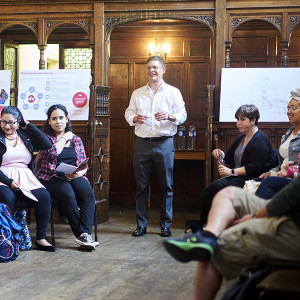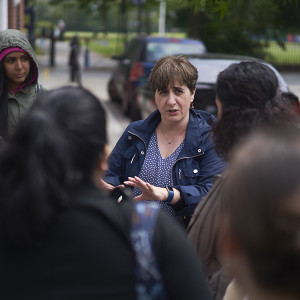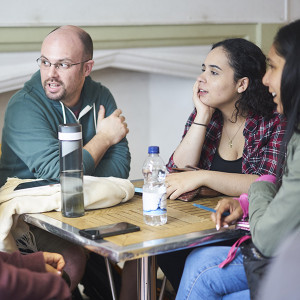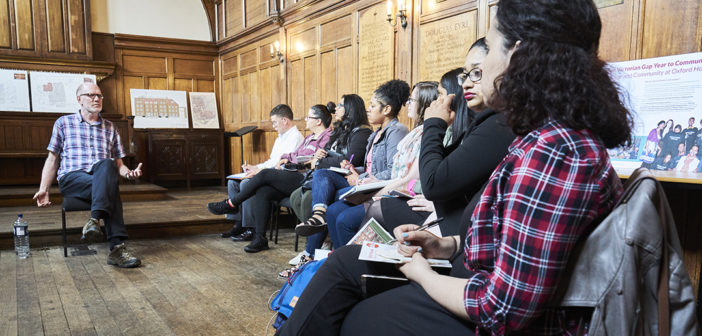Dana Marlow, Ph.D., associate clinical professor of social work, joined Acevedo in lecturing and Nancy Wackstein, GSS director of community engagement and partnerships, helped coordinate site visits on both sides of the Atlantic.

Gregory Acevedo at Oxford House
“Most of the U.S. social welfare history traces back to England, starting with the poor laws from the Elizabethan era,” said Acevedo.
England gave rise to two traditions that would become the basis of social work as a profession: the charity organization societies and the settlement houses. Settlement Houses were created as a new way to care for the underserved: activists “settled in” to live among the poor, better understand their needs, and to help out.
The charity organizations promoted the casework tradition, where social workers would come into the community as day workers to assist individual clients. The settlement house tradition sprung from religious ethos at the Universities of Oxford and Cambridge. Students from the universities were recruited to live in the communities they served.
“The brilliance was that it was the first innovation as a community-based practice model where practitioners would live among the population,” said Acevedo.

Dana Marlow, Ph.D., associate clinical professor, also lectured during the London tour.
Among the first settlement houses were Toynbee Hall and Oxford House, both of which Fordham students visited during their trip to London this past June. The first populations that Toynbee served were Jewish and other immigrant populations; now it primarily serves a Bangladeshi population. The students also visited a local mosque with robust community programming.
Acevedo said that he was very interested in highlighting for the students the role that universities and faith-based institutions played in social welfare and reform, and also in seeing how institutions and professions adapted to changing populations and contexts.
“I wanted them to see new school approaches as well,” said Acevedo.
Students met with CEOs from both of the London settlement houses they visited “to look at the dollars and cents as well the programming,” he said, adding that even some of the most established settlement houses have closed over the years.
“Settlements houses have changed the type of services they offered over the years, but places like Toynbee Hall continue to work on national and local policy, as they always have,” he said.

Social work students in conversation at Oxford House
He added that after more than a century, Oxford House nearly closed too. But the organization recently turned a corner by introducing social enterprise components and other innovations to their business model. The difference between the physical plants of Toynbee and Oxford was stark. Students visited Toynbee’s sleek offices and then saw buckets catching leaking water at Oxford House.
But as Oxford House is located in the increasingly gentrified Bethnal Green neighborhood (a 15-minute taxi from Fordham’s new Clerkenwell campus), the organization plans to open a café and pub that will fund their nonprofit efforts. Likewise, students also learned of Coin Street Community Builders, whose properties near the Tate Modern museum have allowed that settlement house to create a community development corporation with big time real estate investments—to say nothing of the gastro pub near the National Theater, which left students’ “jaws dropping.”
“These organizations are really old, but not dead,” said Acevedo. “They’re living breathing organizations that have changed dramatically.”




